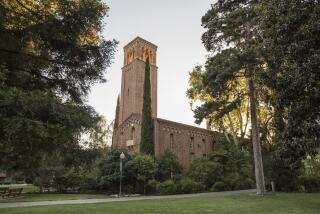Homesteading : Some Kids Rough It in College
- Share via
GRANVILLE, Ohio — It is hard to visualize the three rural cabins that Denison University students call the Homestead as a college dorm.
There is no running water or electricity. Sometimes, it’s necessary to milk the goat before breakfast, and students use an outhouse.
The Homestead is home for a handful of students who are seeking “an escape from the ridiculousness of campus life,” said Prof. Robert Alrutz, faculty adviser to the project.
The student-built cabins are clustered on 200 acres of land about a mile from the main campus of this private school with a student body of 2,100. Four students--three women and a male Swedish exchange student--are living in the cabins during the fall term. In the past it has housed up to 16 students. The number varies from semester to semester, Alrutz said.
Home-Grown Food
Life at the Homestead isn’t easy. Residents grow their own food, some of it in a solar-heated greenhouse added on to one cabin. They cook on wood-burning stoves. Fresh meat is a rarity, but most residents are vegetarians, anyway.
Loosely hung sheets substitute for walls in the cabins. The second-hand furniture is a beat-up reminder of earlier homesteaders, as are the graffiti on the rough wood walls. Outside, chickens strut in the yard, a family of black and orange cats plays in the sun, and Shawn, a brown-and white mongrel who has been at the Homestead since the beginning, sleepily ignores it all.
Getting to class requires a hike through the fields. With the nearest paved road half a mile away, it can be a muddy trek during the spring thaw, or a slip-sliding one during a winter ice storm. On cold nights, forgetting to chop enough wood to keep a fire in the stove means waking up in a cold cabin.
Minor Inconveniences
But to students who live there, these are only minor inconveniences to the experience they gain by living off the land and supporting themselves.
“It’s a humanizing experience,” said Rich Kobe, 18, of Cleveland. Kobe is a sophomore who spent the summer at the Homestead and intends to return for the spring semester. “A real sense of community is built there. Homesteaders depend on each other to keep it going.”
Alrutz--”Daddy A” to the homesteaders--is a professor of biology and coordinator of environmental studies at the school. He’s sympathetic to the reasons some students want to give homesteading a try.
“These youngsters grow up in a way so there’s no call on them to contribute to their own support system. Their only responsibility is to get good grades and stay out of trouble,” he said. “The net result is, when they get a chance to create something with their hands, it’s an emotional experience. They’re almost hungry to do it.”
Began in 1977
The Homestead began in 1977 as an agricultural cooperative that would give students a chance to milk cows, bale hay and generally get the feel of living off the land while helping feed others. Alrutz said it had become one of the few institutions, if not the only one in the nation, created and sustained by students who are absolutely dependent on each other.
“There’s no way in modern life you can totally homestead,” he said. “The trick is to do what you can do without technology.”
More to Read
Sign up for Essential California
The most important California stories and recommendations in your inbox every morning.
You may occasionally receive promotional content from the Los Angeles Times.






